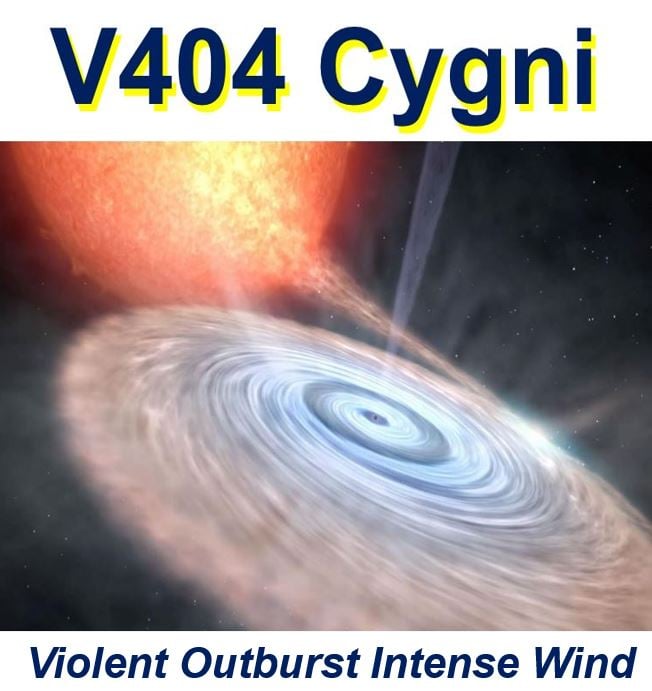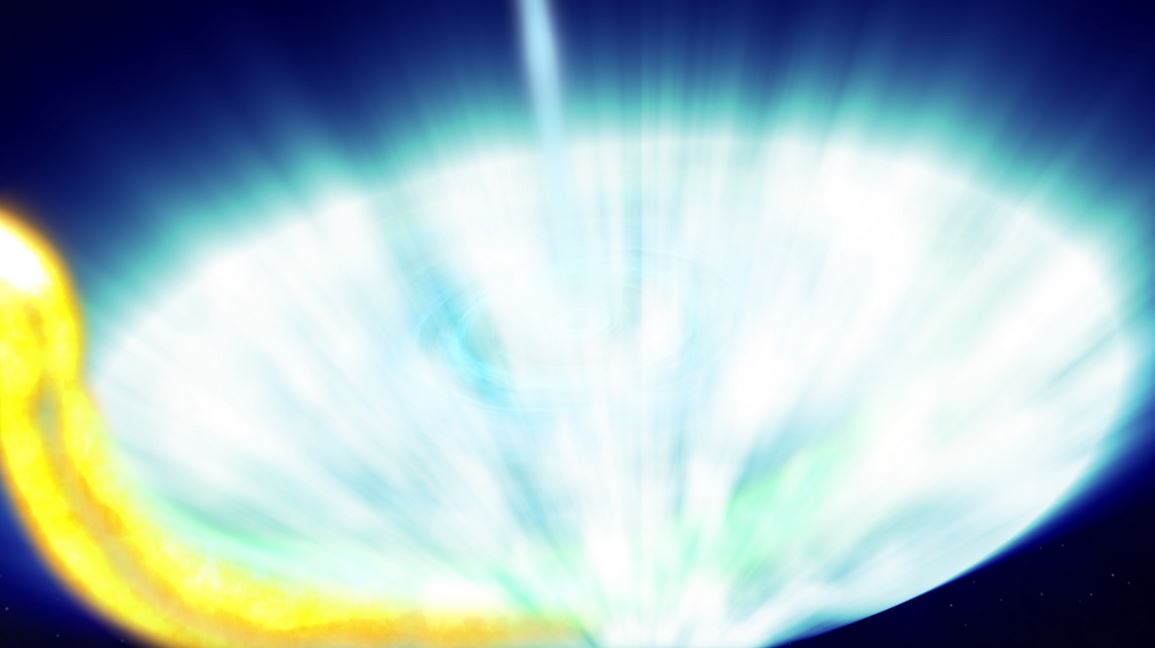A bright and violent black hole, which is relatively near the Earth, was observed last year giving off an intense wind of helium and hydrogen. Scientists from the University of Southampton in England said the black hole – called V404 Cygni – had been sitting quietly for 25 years when it suddenly went wild with a bright and violent outburst.
V404 Cygny is close to Earth – in astronomical terms. It is 7,800 light years away, which as far as we are concerned with our current technology, is still a very long distance. It would take New Horizons, the fastest spacecraft launched so far, 18,449 years to travel just one light year, or 143,902,200 years to get to V404 Cygni.
 An artist’s impression of the accretion disc surrounding the black hole V404 Cygni, where the intense wind detected by GTC becomes evident. (Image: southampton.ac.uk. Credit: Gabriel Pérez)
An artist’s impression of the accretion disc surrounding the black hole V404 Cygni, where the intense wind detected by GTC becomes evident. (Image: southampton.ac.uk. Credit: Gabriel Pérez)
Phil Charles, Professor of Astrophysics at the University of Southampton’s School of Physics & Astronomy, together with scientists from the UK, Spain, Japan, Norway, Germany and France, explained in the prestigious journal Nature (citation below) that they detected an intense wind from one of the nearest known black holes to Earth.
Violent explosion after 25 years of quiescence
While observing V404 Cygni, which went into a violent and bright outburst in June last year, after a quarter of a century of quiescence, the scientists started taking optical measurements of the black hole’s accretion disc using the 10.4-metre Gran Telescopio CANARIAS (GTC), the world’s largest optical-infrared telescope, located in the Canary Islands at the Roque de los Muchachos Observatory (Garafía, La Palma).
The results show the presence of a wind of neutral material – unionised helium and hydrogen – formed in the outer layers of the accretion disc, regulating the accretion of material by the black hole.
This wind, which had never been detected in a system of this type before, has a speed of 3,000 kilometres per second (1,864 miles per second) – the high speed allows it to escape from the gravitational field around the black hole.
 On 15th June 2015, NASA’s Swift satellite detected a rising tide of high-energy X-rays from the constellation Cygnus. Ten minutes later, the Japanese experiment on the International Space Station called the Monitor of All-sky X-ray Image (MAXI) also picked up the flare. V404 Cygni fires up every couple of decades, says NASA. (Image: nasa.gov)
On 15th June 2015, NASA’s Swift satellite detected a rising tide of high-energy X-rays from the constellation Cygnus. Ten minutes later, the Japanese experiment on the International Space Station called the Monitor of All-sky X-ray Image (MAXI) also picked up the flare. V404 Cygni fires up every couple of decades, says NASA. (Image: nasa.gov)
Outburst was very brief
Regarding the short duration of the outburst, Prof. Charles said:
“Its presence allows us to explain why the outburst, in spite of being bright and very violent, with continuous changes in luminosity and ejections of mass in the form of jets, was also very brief, lasting only two weeks.”
When the outburst ended, the GTC observations detected a nebula which had been formed from material expelled by the wind.
This phenomenon, which had never been observed before in a black hole, also allows researchers to estimate how much mass was ejected into the interstellar medium.
Lead author, Teo Muñoz Darias, a researcher at the Instituto de Astrofísica de Canarias (IAC), formerly a Marie Curie Fellow at Southampton and Oxford, said:
“The brightness of the source and the large collecting area of the GTC allowed us not only to detect the wind, but also to measure the variation of its properties on time-scales of minutes. The database obtained is probably the best ever observed for an object of this kind.”
“This outburst of V404 Cygni, because of its complexity and because of the high quantity and quality of the observations, will help us understand how black holes swallow material via their accretion discs.”
Prof. Charles and co-author Jorge Casares, from IAC, two of the discoverers in 1992 of V404 Cygni, concluded:
“We think that what we have observed with the GTC in V404 Cygni happens, at least, in other black holes with large accretion discs.”
In an Abstract in the journal, the authors wrote:
“The large expelled mass (>10−8 solar masses) indicates that the outburst was prematurely ended when a sizeable fraction of the outer disk was depleted by the wind, detaching the inner regions from the rest of the disk. The luminous, but brief, accretion phases shown by transients with large accretion disks2 imply that this outflow is probably a fundamental ingredient in regulating mass accretion onto black holes.”
Citation: “Regulation of black-hole accretion by a disk wind during a violent outburst of V404 Cygni,” T. Muñoz-Darias, P. A. Charles, J. Casares, M. Armas Padilla, M. Linares, D. Mata Sánchez, R. P. Fender, G. Ponti K. P. Mooley & J. Rodriguez. Nature. DOI: 10.1038/nature17446.
Video – Intense wind found in vicinity of black hole
This Southampton University video contains an animation of the accretion disc surrounding the black hole V404 Cygni, where an intense wind was detected last year by the Gran Telescopion CANARIAS.

Comments are closed.